

Simple Solar Power - News. By a1ronzo | May 02, 2013 | 12:05 am | 27 comments Light contains energy.
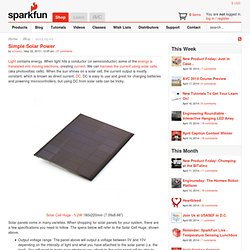
When light hits a conductor (or semiconductor) some of the energy is translated into moving electrons, creating current. We can harness the current using solar cells (aka photovoltaic cells). When the sun shines on a solar cell, the current output is mostly constant, which is known as direct current, DC. DC is easy to use and great for charging batteries and powering microcontrollers, but using DC from solar cells can be tricky. Solar Cell Huge - 5.2W 180x220mm (7.09x8.66") Solar panels come in many varieties. Output voltage range: The panel above will output a voltage between 0V and 10V depending on the intensity of light and what you have attached to the solar panel (i.e. the load).
Cyborg search-and-rescue insects' power source unveiled. 24 November 2011Last updated at 15:51 The research team proposed putting two spiral energy harvesters on either side of a beetle's thorax.
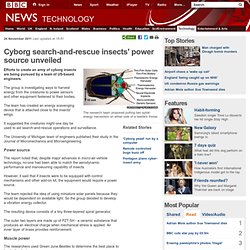
Mechanical Pencil That Draws Carbon Nanotubes Developed By MIT Researchers. Here’s something you may not realize: the graphite in inexpensive pencil lead has the same chemical composition as carbon nanotubes, considered a “Golden Child” of futuristic materials because they make highly sensitive sensors.
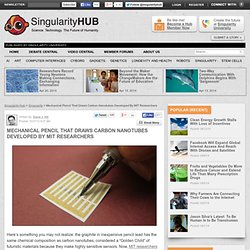
Now, MIT researchers have made their own pencil lead consisting of carbon nanotube powder, allowing fabrication of functional sensors to be literally drawn on paper. As the saying goes, it really doesn’t get any better than this. Previous methodologies for making sensors involved dissolving the nanotubes in dichlorobenzene, which is an organic solvent that is labeled a carcinogen and an environmental hazard. The new approach requires no solvent as the carbon nanotube powder is simply pressed into the form of a pencil lead and loaded into a standard mechanical pencil. MIT unveils Solar cells that can be 3D printed on ordinary paper, plastic or fabric. The new printing process uses vapors, not liquids, and temperatures less than 120 degrees Celsius.
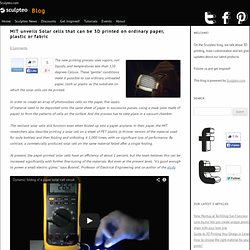
These “gentle” conditions make it possible to use ordinary untreated paper, cloth or plastic as the substrate on which the solar cells can be printed. In order to create an array of photovoltaic cells on the paper, five layers of material need to be deposited onto the same sheet of paper in successive passes, using a mask (also made of paper) to form the patterns of cells on the surface. GravityLight — Using Gravity To Bring Light To The Developing World.
Renewable energies are all the rage these days and are assumed to be a big part of meeting energy demands in the future.

Yet solar, wind, and hydroelectric each have geographic limitations and suffer from intermittent issues that can make their utility not as dependable as one would like. In light of this, what would be ideal is a source of energy that can be utilized at will and available anywhere at anytime. That may be a pipe dream to meet all energy needs, but when it comes to delivering basic lighting to the more than 1 billion people without reliable light, a design and innovation company called Therefore Products believes it has the answer in GravityLight. On the simplest level, GravityLight converts gravitational energy into light, just like its name promises. German student creates electromagnetic harvester that gathers free electricity from thin air. Temporary tattoos could make electronic telepathy and telekinesis possible.
Close, but no cigar.

This goes WAY beyond drones. This is, essentially, the most efficient way to control anything that isn't automated. Just think of this paired with smart contact lenses/glasses. The only thing really holding Google Glass back from its true potential is that it still requires voice and touch controls. How 3D printing could revolutionise the solar energy industry. During President Obama's recent state of the union address, I was particularly drawn to one specific comment he made.
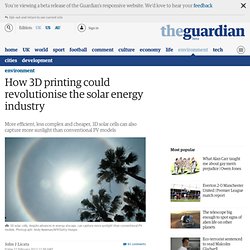
The statement by the president I'm referring to was, "A once-shuttered warehouse is now a state-of-the art lab where new workers are mastering the 3D printing that has the potential to revolutionise the way we make almost everything. " 3D printing has been increasingly used to produce jewellery, dental work, prototyping and even creating human organs. However, as an energy strategist, I'm most excited about the potential for 3D printing to revolutionise solar panel and photovoltaic (PV) cell manufacturing. Stretchy battery drawn to three times its size. 26 February 2013Last updated at 11:39 ET By Jason Palmer Science and technology reporter, BBC News The team tested their battery by stretching it 300% while it powered an LED lamp Researchers have demonstrated a flat, "stretchy" battery that can be pulled to three times its size without a loss in performance.

While flexible and stretchable electronics have been on the rise, powering them with equally stretchy energy sources has been problematic. The new idea in Nature Communications uses small "islands" of energy-storing materials dotted on a stretchy polymer. Researchers develop new technique to scale up production of graphene micro-supercapacitors. (Phys.org)—While the demand for ever-smaller electronic devices has spurred the miniaturization of a variety of technologies, one area has lagged behind in this downsizing revolution: energy-storage units, such as batteries and capacitors.
